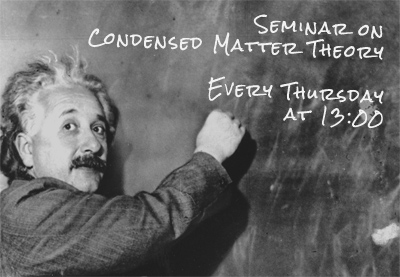Seminar on Condensed Matter Theory
Group of Theoretical Physics at the Department of Condensed Matter Physics
of Charles University has a pleasure to invite you to attend the seminar
on 23rd February 2023 at 13:00
at Faculty of Mathematics and Physics of Charles University, Ke Karlovu 5, 121 16 Praha 2
Seminar room F 052
Karel Carva
DCMP, Faculty of Mathematics and Physics, Charles University, Ke Karlovu 5, 121 16 Prague 2
Magnetism in quasi-2D vanadium trihalides: ab initio calculations
23. 02. 2023 13:00
Karel Carva » Magnetism in quasi-2D vanadium trihalides: ab initio calculations
DCMP, Faculty of Mathematics and Physics, Charles University, Ke Karlovu 5, 121 16 Prague 2
Location: Seminar room KFKL, MFF UK (room F052 - ground floor near the rear staircase, Ke Karlovu 5, Praha 2)
Systems where two-dimensional (2D) layers bound by weak van der Waals (vdW) interaction possess magnetic order are highly interesting for high-tech magnetic, magneto-electric and magneto-optic applications in nanostructures. While thermal fluctuations suppress magnetic order in reduced dimensions, ferromagnetism in CrI3 has been to shown to exist even in an atomically thin layer [1]. This finding has stimulated a lot work aimed at understanding the underlying physics, and initiated studies of similar transition metal trihalides. Here we focus on vanadium trihalides. VI3 is a ferromagnet whose monolayer critical temperature is even slightly higher than that of bulk, TC = 60 K. DFT calculations converge to two strikingly different solutions: either a ground state with quenched orbital momentum, typical for 3d transition metals, or a ground state with exceptionally high orbital momentum [2,3]. Predicted electronic configurations are compared to recent measurements based on the x-ray magnetic circular dichroism [4]. Magnetic and electronic properties differ strongly from the CrI3 case.
Furthermore we perform a complex investigation of lattice and magnetic excitations of VI3 by employing the synergy of DFT calculations of phonon modes, infrared, terahertz, and Raman spectroscopies on bulk single crystals at low temperatures [5]. The transition to the long-range ferromagnetic order is accompanied by the observed variations of phonon frequencies induced by the strong magnetoelastic coupling. Two additional modes emerging below TC may be ascribed to magnons, and dramatically soften at temperatures where a lattice distortion has been reported in the literature.
VBr3 was originally believed to be a layered antiferromagnet (AFM), similarly to the intensively studied CrI3. Our calculations predict a different ground state, zig-zag AFM, consistenly with high-field measurements. We also find how the relaxation of halogen atom positions affects the orbital occupation in the ground state, and in turn magnetic interactions and anisotropy. These findings suggest the possibility of controlling magnetic anisotropy in this system by selective occupation of specific lattice modes.
Furthermore we perform a complex investigation of lattice and magnetic excitations of VI3 by employing the synergy of DFT calculations of phonon modes, infrared, terahertz, and Raman spectroscopies on bulk single crystals at low temperatures [5]. The transition to the long-range ferromagnetic order is accompanied by the observed variations of phonon frequencies induced by the strong magnetoelastic coupling. Two additional modes emerging below TC may be ascribed to magnons, and dramatically soften at temperatures where a lattice distortion has been reported in the literature.
VBr3 was originally believed to be a layered antiferromagnet (AFM), similarly to the intensively studied CrI3. Our calculations predict a different ground state, zig-zag AFM, consistenly with high-field measurements. We also find how the relaxation of halogen atom positions affects the orbital occupation in the ground state, and in turn magnetic interactions and anisotropy. These findings suggest the possibility of controlling magnetic anisotropy in this system by selective occupation of specific lattice modes.
References
[1] B. Huang, et al., Nature 546 (2017) 270
[2] L. M. Sandratskii and K. Carva, Phys. Rev. B 103 (2021) 214451
[3] K. Yang, F. Fan, H. Wang, D.I. Khomskii, H. Wu , Phys. Rev. B 101, 100402 (2020).
[4] D. Hovančík et al., Nano Lett. (2023) doi: 10.1021/acs.nanolett.2c04045
[5] D. Hovančík et al., J. Phys. Chem. Lett. 13, 11095 (2022)
[2] L. M. Sandratskii and K. Carva, Phys. Rev. B 103 (2021) 214451
[3] K. Yang, F. Fan, H. Wang, D.I. Khomskii, H. Wu , Phys. Rev. B 101, 100402 (2020).
[4] D. Hovančík et al., Nano Lett. (2023) doi: 10.1021/acs.nanolett.2c04045
[5] D. Hovančík et al., J. Phys. Chem. Lett. 13, 11095 (2022)


